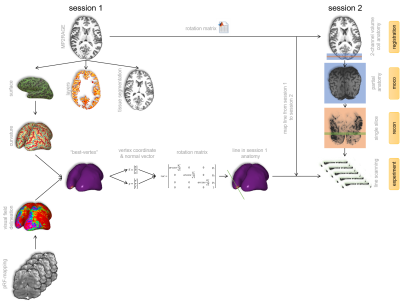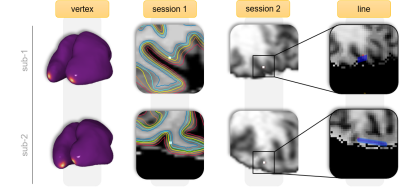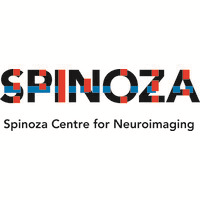Jurjen Heij1, Luisa Raimondo1, Jeroen C.W. Siero1,2, Serge O Dumoulin1,3, Wietske van der Zwaag1, and Tomas Knapen1,3
1Spinoza Centre for Neuroimaging, Amsterdam, Netherlands, 2Radiology, University Medical Centre Utrecht, Utrecht, Netherlands, 3Experimental and Applied Psychology, VU University, Amsterdam, Netherlands
1Spinoza Centre for Neuroimaging, Amsterdam, Netherlands, 2Radiology, University Medical Centre Utrecht, Utrecht, Netherlands, 3Experimental and Applied Psychology, VU University, Amsterdam, Netherlands
We show here the
feasibility of anatomically and functionally informed planning of line-scanning
fMRI experiments. Contralateral visual stimulation evoked a positive
BOLD-response, while ipsilateral stimulation mostly evoked negative responses.

Figure
2. Acquisition and
processing workflow. Surface reconstruction and segmentations were
obtained from the first MP2RAGE. The best vertex was derived from pRF-data and
minimal curvature indices. A registration matrix between the MP2RAGE from
session 1 and session 2 was applied to our best vertex, resulting in the
optimal position in the second session.

Figure 4. Vertex position across intra-subject
spaces. Two representative subjects illustrating the registration cascade to
warp the vertex from surface, to session 1, to session 2. Following the procedure
outlined in Figure 2, we calculated the angles of the normal with each cardinal
axis to obtain a line mostly perpendicular to the patch of cortex that
colocalized with the point-of-interest (neurological convention; subject left is on the left).
